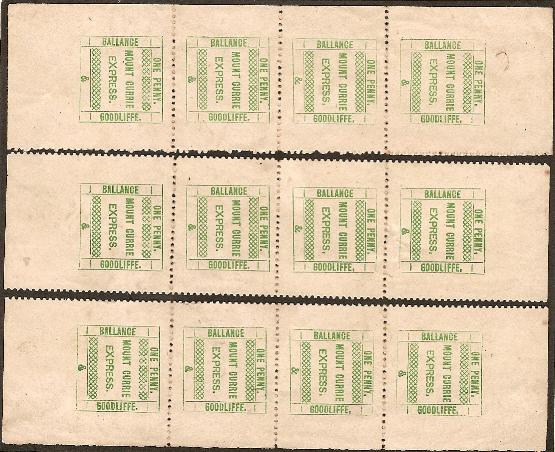
IMMAGINI RELATIVE AI MIEI MESSAGGI
per il FORUM FILATELIA e FRANCOBOLLI pagina 128
FORUM CONTINUA 128: Qui parleremo delle storie che stanno "dietro i francobolli".
In proseguimento da pagina 127, ecco la versione in inglese di un articolo di Victor B. che ci racconta tutto su un raro francobollo di posta locale di FOX HILL (Natal, SudAfrica).
Victor mi ha anche inviato uno splendido scan del suo ultimo acquisto, che sarà oggetto di una nuova "Storia dietro i francobolli".
QUIZ: Chi sa di cosa si tratta? Quanto è raro questo sheet ricostruito per intero?

cosa è? E' raro?
La risposta è nell'articolo a fondo pagina. Di fatto questo è l'unico foglio completo di questo rarissimo francobollo.
“the only known surviving complete sheet of the Mount Currie Express stamp.”
Bene, ritorniamo al nostro Fox Hill:
premessa: tutto era nato dai quiz di pagina 127 in cui si chiedeva di identificare anche il seguente francobollo:
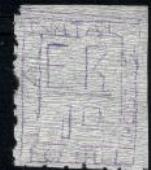
identificare il francobollo dell'immagine e raccontarne la storia
Il francobollo di FOX HIll in versione "carta da sigarette" (quasi sicuramente un falso) ci permette di introdurre i veri francobolli di FOX HILL.
Clicca QUI per tornare a pagina 127, dove vedremo di mettere, a fondo pagina, una versione in Italiano di questo stesso articolo.
FOX HILL, NATAL, THE STAMPS OF PRIVATE CURIER SERVICE OF 1902
One of the very important references for the collectors of Locals, Phantoms and Fantasies as well as for the ASFE enthusiasts is a book by Frederick John Melville “Phantom Philately”, published in 1923. Many of the curious items described by F. Melville were proven later, by ardent researchers, to be bona fide Local Posts, rather then inventive speculative or bogus issues. One of the curiosities is listed as Natal, Fox Hill.
On pages 143 -144 of his book, F. Melville writes:
‘In 1902 the Philatelic Monthly Referee received a letter from a correspondent in Natal, with the 1d Natal stamp, and in addition a label, of which the accompanying is an approximate representation.’ (Fig.1).
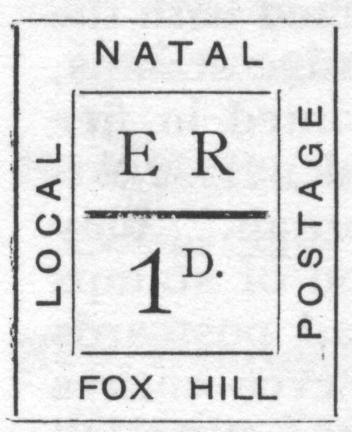
fig.1 da "Phantom Philatly" by Melville
[It is not clear from the above reference, if the label was enclosed inside the letter or affixed on the letter together with 1d Natal stamp? V. B.]
‘It was followed by the explanation that it was” used for franking correspondence carried across country per Kaffir runners… they were printed by the ‘Pinhole’ process. “The Stamp Collectors’ Fortnightly later obtained a full history from the originator, and it is sufficiently frank to outclass the Fox Hill labels from any category of local postage stamps:
It was simply a private local manufactured by myself and used on letters which my native carried to a friend of mine some few miles off. This Kaffir was paid at the end of the moth at the rate of one penny for each letter he had carried during that period. Not wishing to take the trouble of making a note of each letter or packet I sent, I printed a certain number (100) of this stamp and dispatched half to my friend. At the end of the month it was of course plain to see how many letters had been carried each way by the number each of us had left. Thus each paid his own postage in a lump sum. Being dissatisfied with the first design I subsequently manufactured a second and finally a third type, printing 40 of the former and 50 of the latter. When my friend moved away a short time ago it was more convenient to write per Post and hence the Local Service was discontinued.
The stamps appear to have been made on home –made duplicator or perhaps cyclostyle ( which may explain the “Pinhole” process); the first type is approximately as illustrated; the second type has a three-letter monogram in place of ER., and the third has a very amateurish profile portrait.’
In his introduction section F Melville had asked: “Where, in my present list, there is no illustration, I should be glad to have the loan of copies in the possession of the readers”.
In case of the Fox Hill, Natal, F. Melville had only an “approximate representation” to illustrate (Fig.1).
For the philatelic record and the viewing pleasure of our readers, I would like to demonstrate all 3 types of the Natal, Fox Hill issues. The items illustrated (Fig.2) were offered on Stephan Welz & Co auction of South Africa on 21 October 1992, lot 474.
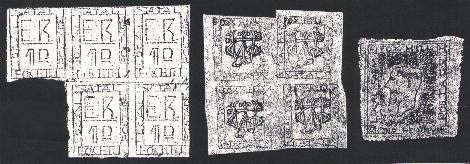
fig.2 lot 474 (images are ugly due to impossibility to scan original stamps)
Type 1, with E R / 1 D in the center, NATAL on the top, LOCAL on the left, POSTAGE on the right and FOX HILL on the bottom differs from the Phantom Philately approximate illustration in the number of characteristics: 1) ER is much larger and in comic type. 2) 1 is in double lines, D in 1D is without serifs, has a line underneath and no period. 3) Upper and lower inscriptions Natal and Fox Hill are boxed by the rectangular frames and large enough to touch upper and lower lines of the box. 4) Side inscriptions also are larger and are touching the frames.
Type 2, with a fancy T. W. J. monogram inscribes: FOX HILL on the top, NATAL on the bottom, LOCAL POST on the left, ONE PENNY on the right.
Type 3, with a portrait of King Edward VII inscribes: FOX HILL on the top, ONE PENNY on the bottom, LOCAL FARM on the left, POSTAGE on the right.
The lot description gives additional information, not known to F. Melville.
Type1 was printed in Blue. Type 2 and Type 3 were printed in Purple. The lot 474 description states: “Circa 1902 Fox Hill Locals. Interesting group comprising examples of the three diff 1d ‘local post’ labels prepared by two farmers living in the dist of Fox Hill early this century (the one has been identified as a Mr. T.W. Jackson who was also a practicing attorney and the other is thought to have been the post master at Fox Hill), the stamps were utilized for their interchange of mail by native runner, the process was apparently that of cyclostyle printing and perforating was evidently carried out on the sewing mashing, … considered extremely rare with a total of only 17 copies known from first design, 12 from second design plus 6 from third design and all forming the part of recent find, also written up recently in the S.A. Philatelist.”
The 1993 Phillips auction in England gives additional information on Fox Hill locals in the lot 512 description (Fig.3), stating that they were printed on paper with the "usual thick gum".
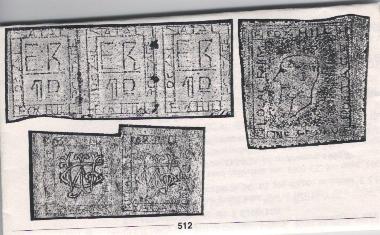
fig.3 lot 512 (images are ugly due to impossibility to scan original stamps)
The numbers reported as known are very different from the numbers reported, by the originator of service as manufactured, to the Stamp Collectors Fortnightly publication.
Using the
critical and investigative approach to the information presented, it is not
clear if the post was actually existed or was only intended, since no specimen
is known used on cover or even canceled. Despite
the ‘Local Post’ and ‘Postage’ inscription on the stamps, the Fox Hill
issues are missing two important characteristics of the bona fide local post,
as could be
concluded on the information presented in Phantom Philately. The service letters
was not forwarded to or from the G.P.O. and service was not available to a
general public, like in case of the XIX Century U.S. classic L.P. or Swiss Hotel
Posts. Therefore, the most fitting status, for Fox Hill stamps, may be concluded
from priory known information, is that of the Private Currier Service.
![]() Last news: Cinderella collectors may
look differently to the Fox Hill issues in light of the new information.
Last news: Cinderella collectors may
look differently to the Fox Hill issues in light of the new information.
It is difficult to expect the rather large amount of mail between two simple farmers.
Therefore,
the presumptive status for the Fox Hill issues in Phantom Philately is rather
negative that is of bogus, fantasies or philatelic speculative with a rather
large print of 100, 40 and 50 stamps. However, the newly discovered information,
that the farmers in Fox Hill were practicing attorney and postmaster brings
forward a few logical presumptions that could easily qualify the issue to the
status of Local Post stamps.
Three features should be presented for the issue to be qualified as bona fide local post:
1) Connection to the general post office mail stream.
2) Availability or service to the general public.
3) Acceptance by the local authority.
While on the distant farm, the practicing attorney should receive rather large amount of legal mail, forwarded to and from him by the local postmaster. It is very possible that the Post Office regulations would base a frequency of the mail delivery as determined by the amount of the public or public interests in any certain location.
Servicing his legal clients in more efficient and timely manner, could be viewed by attorney as serving the public interest. To make the service available to the local postmaster (who was also part of public and the local postal authority), was a legal compromise between the friends, because both of them were not willing to make the frequent trips of the few miles and was easier to pay native runner.
Despite the unclear status of the Fox Hill stamps, most of the advanced collectors of local stamps, known to this writer, have Fox Hill issues on their want lists.
N.d.r = this article was published for the first time in the magazine The Cinderella Philatelist of London, January 2007.
Ecco ora l'articolo sul Mount Currie Express. E' in inglese, ed è stato scritto dall'amico Victor Berkovich. L'articolo è apparso sul magazine C.P. di Londra dell'ottobre 2007:
New Griqualand: the Mount Currie Express local post
By Victor B.
The territory that was officially called Nieuw Griqualand in 1863-1877 belonged to Griqua nation. This land, North East from Natal, was granted to the Griquas by British Colonial Government as a resettlement deal, in exchange to the prior Griqua’s home in Griqualand West. Prior to Griqua arrival the territory was called No Man’s Land. The name East Griqualand was adapted only in 1877, after annexation to the Cape Colony. In 1976 East Griqualand was made an independent homeland called Transkei.
In 1863-75 this territory was ruled by Griqua chief (Kaptyn) Adam Kok III, who presided over legislative brunch of the native government called Raad. Carol Birkby described Raad as “the most comic and pathetic among all the Parliaments which have ever sat”. Reverend Dower had described the sessions of Raad as fallows: “The Raad sittings were held half yearly. Very imperfect accounts of its proceedings were kept. The duration of the Parliament depended on the size of the animal slaughtered. No beef, no business, was the unwritten, but standing rule of the Assembly.”
Nevertheless, New Griqualand was recognized by the British Colonial Government of Cape of Good Hope as independent sovereign state until 1875. When Adam Kok visited the Governor of Cape in 1868, he was told that he was,” entirely independent of the Cape Government”. When Adam Kok applied to Sir Philip Woodhouse for the appointment of the High Commissioner,” he was told to manage as best as he could, he would not be interfered with.” Since Griquas were denied British protection, many state infrastructures, like public postal service, were not provided for. Cape Colony or Natal postal services did not extend into the New Griqualand. Only at the end of 1874 the British High Commissioner was appointed to oversee and to protect the Griquas. It was not till February of 1875, that the Griquas were accepted as British subjects. The territory was finally annexed to the Cape Colony in 1877, after Adam Kok’s death.
The Mount Currie laager (fort) was the seat of Griqua Government from 1863 to 1873.
Rev. Murray and Rev. Dower had established a new town 3 miles away. Due to the Rev. Dower insistence and activities to improve the Griquas crowded living conditions at the laager, Adam Kok had moved his home from Mount Currie to new town in March of 1873, which was named Kokstad. However, most of the Mount Currie residents were reluctant and slow in moving away from the overcrowded Mount Currie laager, until the end of 1874.
In the summer of 1872 the Durban based company Ballance and Goodliffe had established a trading store at Mount Currie, with Wesley Darby as a general manager. Under Darby’s management the first public postal service was established on the territory of Nieuw Griqualand. One penny stamp for this service was issued in 1874. Many mint stamps of Mount Currie Express are known to philatelist, due to the discovery by Emil Tamsen in 1889 the large stock of unused stamps.
However, since 1889, for more then a Century, only one assumingly accepted as used stamp of Mount Currie was known to philatelists. This stamp is illustrated in T.M. Mullins booklet Mount Currie Express: The Stamp of Griqualand East (Fig. A). The illustration in Fig.A is rather poor, but importantly the position of the cross cancel is still clearly visible.
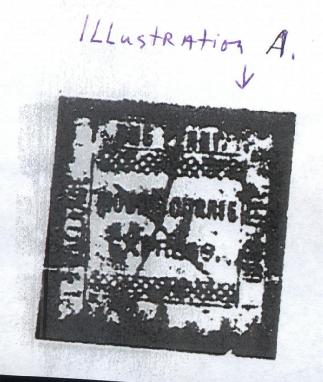
fig. A
Leading South African philatelist, Johnson Philatelics Ltd. of Port Elizabeth, Natal, on 7th March 1995 postal auction had presented lot 316 with a description: “Mount Currie Express 1874 1d yellow green perf 12 and ½. The apparently unique used example: margins all around, with central manuscript ink cross cancellation. This stamp illustrated by Mullins in his publication on this issue. Rare (Fig.B)”.
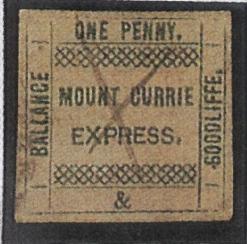
fig. B
The position of the cross cancel in Fig.A is clearly different then in the Fig.B. Lower left bar crosses X, instead of crossing P of Express. The upper left bar extends all the way to O of One, instead of ending above O of Mount. Therefore, we have the record of the second used example of the Mount Currie stamp.
Recently, from European source, this writer was lucky to obtain the stamp of Mount Currie with a cork cancel (Fig.C).
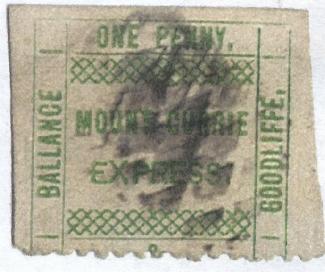
fig. C
This researcher can see, barely discernable under smudgy cork cancel, the manuscript ink pen writing. More prominent stands the writing of numbers 2/ 7, or 4. 7. In XIX Century very often number 4 was written with the left part in the shape of number 2. Quite possibly the numbers could stand for date 4th July 1874 or 7th of April 1874?
It is interesting to note that Wesley Darby had also used to write number 4 with left part in shape of number 2. In this peculiar manner Darby had written 4 of 1874 in the dated 2nd January1874 Declaration of charges adapted for conveyances of letters, books and parcels. This manuscript document was sign by W. Wesley Darby, Pro Ballance and Goodliffe.
This interesting document also announced: “Stamps to be obtained at the Mount Currie.”
This writer interprets above as “the stamps will be available soon at the trading store”.
The declared charge for letters of 1d to and from Mount Currie and Harding (the nearest post office in Natal since summer of 1873) appear rather normal and congruent with the function of Mount Currie Express stamp. However, the same charge for letters “to and from any part of Colony of Natal to mount Currie” appears rather incongruent and most likely indicates to intended, but unrealized function of the same stamp. It is also quite logical to assume that the Declaration for the new and intended service would be issued in advance of the issue and perhaps printing of the stamps of Mount Currie Express.
The Mount Currie stamps were printed in the sheets of twelve with rather oversized margins. The reconstructed sheet, from the author’s collection is presented here in Fig.4. All three of the illustrated in figures A,B,C used stamps have oversized margins trimmed.
Several references indicate that picking up the mail from the neighboring Natal was more of the function of post in New Griqualand, rather then sending outgoing letters.
The Killie Campbell 1978 reprint of Dowers’s book, The Early Annals of Kokstad and East Griualand, carries the following notes on page 144:
Goodliffe and Balance were a Natal trading firm. In 1873 they opened three stores, one at Mount Currie and two in Matatiele District. News of the death of Dowers father was delayed because Darby (manager of the Mount Currie store) refused to collect letters for Dower, who denounced him for supplying liquor to Griquas.
The Sovereign of Griquas, Kaptyn Adam Kok III was not interested in establishing a postal communication on his territory. Dowers in his Annals (at page 31) referring to 1870, states:
“Our position was isolated indeed. The nearest post office was Umzimkulu Drift (Natal), 50 miles away, from whence we received letters and papers once a month, if we choose to send for them. Regular post there was none. Adam Kok did not believe in sending for letters; he thought he was better without them.”
It appear from above references that to pick up letters and papers from the closest functioning post in Natal was more common duty of the native runner then carry the outgoing mail. Highly likely and therefore, it is this writer speculation that the stamps with a cross cancel served as receipts for picking up the mail and the cork cancel was employed for outgoing mail. In both cases, at the time of use the large oversized margins of the stamps were trimmed by scissors. It is also highly likely that the post of W. Darby had still functioned and the stamps of Mount Currie Express were still used at around 4th of July 1874.
END
Bibliography:
1) T.M. Mullins. The Mount Currie Express: The stamps Of East Griqualand.
2) C. S. Balson and Graham, “Kence – The Trade Tokens of Strachan & Co.”
3) Birkby, Carel. , “Zulu Journey” (1936)
4) Scott Balson Trust. Provisional Tariff of Charges adapted by Messrs Balance and Goodliffe for conveyances of letters, papers Books, Parcels. Manuscript, 2nd January 1874. www.tokencoins.com/griqua/mull09.gif
5) Noel Roberts, The Mount Currie Express. The “Ugly Duckling” of the Philatelic World. The South African Philatelist. March- April 1944.
6) Balson, Scott., Internet pages, The Griqua nation – New Promise in Nomansland.
www.tokencoins.com/griqua4.html
NEWS
![]() A
fantastic website is dedicated to Locals of the world. Visit it at:
A
fantastic website is dedicated to Locals of the world. Visit it at:
http://www.philateria.com/index.html
Particularly you may read information about another local carrier of South Africa the "Bakker Express Company". Read it at:
http://www.philateria.com/html/bakker_history.html
------------------- °°°°°°°°°°°°°° --------------------
Mi
scuso per eventuali imprecisioni, infatti, per risparmiare tempo,
mi sono affidato solo alla mia memoria. Per certo posso fornire le fonti -
sicuramente più attendibili di me - da cui ho tratto le varie informazioni.
Se volete approfondire i vari argomenti, contattatemi.
Su questo sito potete vedere immagini, articoli e approfondimenti
ai temi discussi nei miei messaggi per il forum Filatelia e Francobolli.
Chi
fosse interessato ai bolli della seconda guerra mondiale, a quelli dei
prigionieri di guerra o di propaganda psicologica, alla resistenza, nonché
alla storia contemporanea, incluse le missioni di pace italiane nel mondo e
quelle scientifiche al polo sud, può visitare le oltre 500 pagine, in italiano
ed in inglese, del sito, cliccando semplicemente sul tasto
"Iniziale" qui sotto. Gli
altri tasti aiutano la navigazione all'interno di questa sezione "le
storie dietro i francobolli" e "Curiosità filateliche". Precisamente:
il sommario riporta gli argomenti trattati in ogni pagina; i tasti dall' 1 al
156
aiutano ad accedere direttamente alle prime xx pagine (12 per volta) ed infine
c'è il link alla corrispondente pagina/pagine del Forum di F&F in cui
lo stesso "topic" è stato discusso. ![]() NOVITA': Se cercate uno specifico argomento ed il Sommario
non è esauriente, potete provare con il nostro motore di ricerca. Esso funziona
all'interno del sito, e può essere utilissimo. Basta scrivere la
parola che si cerca, nel rettangolo qui sotto e cliccare a destra su "find".
La ricerca può essere
fatta con una singola parola, con più parole ed anche con un * alla fine di una
parola se si vuole interrogare sia il singolare che il plurale di una parola.
Per esempio facendo la ricerca con la parola mission*
si cercano tutte le pagine del sito, che contengono le seguenti parole:
missione, missioni ed anche mission, e missions, etc. Invece per ricercare
più parole, basta metterle fra virgolette. Per esempio "volo di
ritorno". NOVITA'
NOVITA': Se cercate uno specifico argomento ed il Sommario
non è esauriente, potete provare con il nostro motore di ricerca. Esso funziona
all'interno del sito, e può essere utilissimo. Basta scrivere la
parola che si cerca, nel rettangolo qui sotto e cliccare a destra su "find".
La ricerca può essere
fatta con una singola parola, con più parole ed anche con un * alla fine di una
parola se si vuole interrogare sia il singolare che il plurale di una parola.
Per esempio facendo la ricerca con la parola mission*
si cercano tutte le pagine del sito, che contengono le seguenti parole:
missione, missioni ed anche mission, e missions, etc. Invece per ricercare
più parole, basta metterle fra virgolette. Per esempio "volo di
ritorno". NOVITA'
![]() QUI LA SEARCH ENGINE per ricerche all'interno di tutto il sito:
QUI LA SEARCH ENGINE per ricerche all'interno di tutto il sito:
 |
 |
|
|